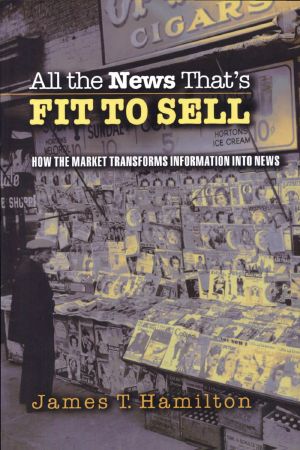All the News That's Fit to Sell · How the Market Transforms Information Into News

- Authors
- Hamilton, James T.
- Publisher
- Princeton University Press
- Tags
- language arts & disciplines , journalism , social science , sociology , general , media studies , news , non-fiction , capitalism
- ISBN
- 9780691116808
- Date
- 2003-12-22T00:00:00+00:00
- Size
- 2.50 MB
- Lang
- en
That market forces drive the news is not news. Whether a story appears in print, on television, or on the Internet depends on who is interested, its value to advertisers, the costs of assembling the details, and competitors' products. But in All the News That's Fit to Sell, economist James Hamilton shows just how this happens. Furthermore, many complaints about journalism--media bias, soft news, and pundits as celebrities--arise from the impact of this economic logic on news judgments.
This is the first book to develop an economic theory of news, analyze evidence across a wide range of media markets on how incentives affect news content, and offer policy conclusions. Media bias, for instance, was long a staple of the news. Hamilton's analysis of newspapers from 1870 to 1900 reveals how nonpartisan reporting became the norm. A hundred years later, some partisan elements reemerged as, for example, evening news broadcasts tried to retain young female viewers with stories aimed at their (Democratic) political interests. Examination of story selection on the network evening news programs from 1969 to 1998 shows how cable competition, deregulation, and ownership changes encouraged a shift from hard news about politics toward more soft news about entertainers.
Hamilton concludes by calling for lower costs of access to government information, a greater role for nonprofits in funding journalism, the development of norms that stress hard news reporting, and the defining of digital and Internet property rights to encourage the flow of news. Ultimately, this book shows that by more fully understanding the economics behind the news, we will be better positioned to ensure that the news serves the public good.
"At what price do we get our news? The role of economics in defining
the nature of contemporary journalism has never been better explained. A
valuable, important book for those of us who watch, read, or listen to
the news." --Marvin Kalb, Senior Fellow, Joan Shorenstein Center on the Press, Politics and Public Policy
"Forget
everything you thought you knew about the news media. Jay Hamilton's
lively, sophisticated analysis shows how powerful economic forces
determine what we read and see on the news every day. The ills of media
bias, celebrity journalism, and fluff coverage are just pieces of a much
larger puzzle that Hamilton creatively assembles for us. Once you read
this brilliant book, you'll finally understand what must be done to
change and improve the news media." --Larry J. Sabato, Director, University of Virginia Center for Politics
"This
is by far the best book in a new and growing field--economics of the
media, one of the most important and neglected parts of economics. James
Hamilton, the leading authority in the area, has produced a seminal
analysis." --Tyler Cowen, author of Creative Destruction
"This
is a superior piece of work. No other book does as good a job of
analyzing economic factors shaping the news. One of the very few
economists seriously examining the media, James Hamilton not only offers
the single best analysis I have ever seen of the economic reasons
objectivity became the hallmark of professional journalism, but has also
done a superb job of looking at the economic factors shaping television
news." --John Maxwell Hamilton, Marketplace Commentator and Dean, Manship School of Mass Communication, Louisiana State University
James T. Hamilton is Charles S. Sydnor Professor of Public Policy,
Economics, and Political Science at Duke University. He has written or
coauthored six books, including Regulation through Revelation and Channeling Violence (Princeton), which won the Shorenstein Center's
Goldsmith Book Prize. He is also a recipient of the David N. Kershaw
award for distinguished public policy research.